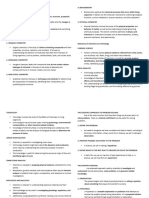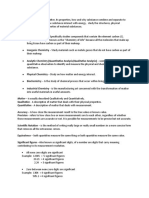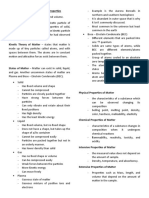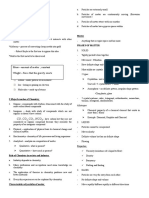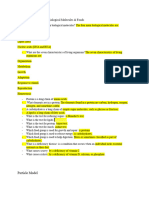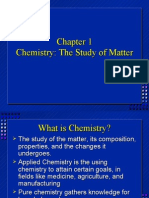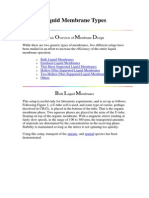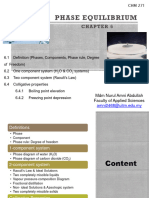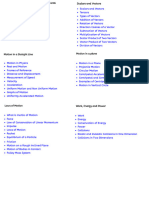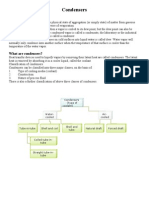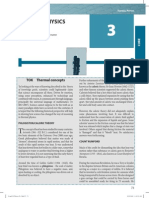SCIENCE REVIEWER
Scientific Models -
representations of natural
phenomena that scientists use to
explain and predict real-world
processes.
Examples of Scientific Models:
1. Objects that are small to see
2. Objects that are too large to
see
3. Objects that have not yet been
discovered
4. Objects that no longer exist
5. Events that occur too fast
6. Events that occur too slowly
3 Types of Scientific Models:
1. Physical Model - tangible
�representations of an object or
system. They can be large-scale
(like a model of a
�cell).
2. Mathematical Model - created
using mathematical language
and equations to describe
relationships between variables
in a system.
3. Conceptual Model - present
ideas, behavior, and
comparisons; simplified
representations of complex
systems or processes, often in
the form of a diagram or
flowchart.
Matter - anything that occupies
space and has mass.
Pure Substance - unique
composition that makes it distinct
from other pure substances.
�1. Element - building blocks of
matter; made up of only one type
of atom; cannot be broken down
into smaller substances
�by physical means.
Examples: Iron (Fe), Silver (Ag),
Antimony (Sb), Copper (Cu), Tin
(Sn), Tungsten (W). Additional
notes: Carbon (burning
something), Copper (conducts
electricity), Silicon (surgical and
beauty cosmetics), Lead (toys).
2. Compound - chemical
combination of more elements
combined chemically in fixed
proportions; can be broken down
into simpler products by chemical
means.
Examples: Water (2 Hydrogen
Atoms + 1 Oxygen Atom),
Hydrogen Peroxide (2 Hydrogen
Atoms + 2 Oxygen Atoms),
Glucose (6 Carbon Atoms + 12
�Hydrogen Atoms + 6 Oxygen
Atoms), Salt (Sodium atom +
Chlorine atom).
Mixture - 2 or more pure
substances combined; can be
separated by physical
�means; no fixed compositions or
ratios.
Homogeneous - called solutions;
have uniform composition; can
be seen as one phase.
Examples: Solid (Brass), Liquid
(coffee), Gaseous (air), Gas-Gas
(air), Liquid-Liquid (vinegar),
Solid-Liquid (sugar solution),
Solid-Solid (alloy).
Heterogeneous - have no
uniform composition; can be in
different phases.
Examples: Solid (salad), Liquid
(ice cubes in a drink), Gaseous
(smog).
Suspension - particles settle out
with the pressure of gravity.
�Examples: Sand, Antibiotics.
Colloid - particles do not settle
out over time. Examples: Gel,
jelly, milk,
�toothpaste, beer, bread, body
creams, ice cream, yogurt.
5. States of Matter:
1. Solid - molecules are closely
packed together; contains the
least amount of kinetic energy;
definite shape and volume.
2. Liquid - particles are less
tightly packed than solids;
contains more kinetic energy
than solids; has definite volume
but not a definite shape.
3. Gas - particles are far from
each other; contains the greatest
amount of kinetic energy; has no
fixed shape or volume.
4. Plasma - highly ionized gas
particles; has free electrons and
�charge ions; commonly found in
stars, lightning, and industrial
processes.
5. Bose-Einstein Condensate -
cooling a gas of bosons to near
absolute zero (0
�Kelvin or -273.15 degrees
Celsius); crucial for BEC
formation; at these temperatures,
thermal energy is minimal, and
atoms can enter the same
quantum state.
Phase Change - the conversion
of matter from one state to
another; this process occurs
when a large amount of energy is
gained or lost.
- Endothermic - phase changes
that require the addition of
energy.
- Exothermic - phase changes
that require the subtraction of
energy.
Phase Changes:
�1. Melting - changing from solid
to liquid (absorbs heat energy).
2. Freezing - opposite of melting
(liquid to solid).
�3. Vaporization - changing from
liquid to gas (absorbs heat
energy).
4. Condensation - a substance in
the gas phase that loses heat
changes to liquid (gas to liquid).
5. Sublimation - heat absorption;
requires energy input to
overcome intermolecular forces
holding the solid together (solid
to gas).
6. Deposition - heat release
when a substance in gas form
changes state to become a solid,
bypassing the intermediate liquid
state (gas to solid).
Scientific Method - a step-by-
step process used to explore
questions and find answers
�through observation and
experiments; involves asking a
question, making a guess
(hypothesis), testing it through an
experiment, and then analyzing
the results to draw conclusions.
�Steps:
1. Question
2. Research
3. Hypothesis
4. Experiment
5. Collect Data
6. Analyze
7. Conclude
8. Report
9. Provide feedback


















